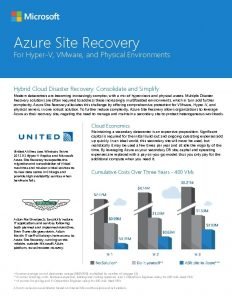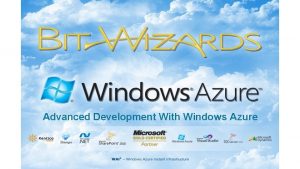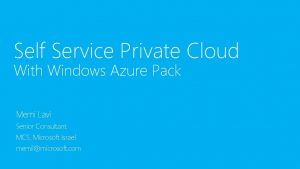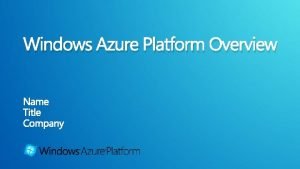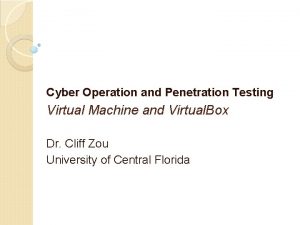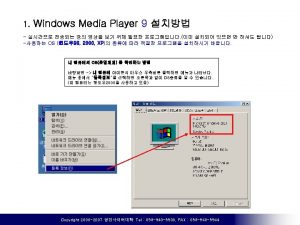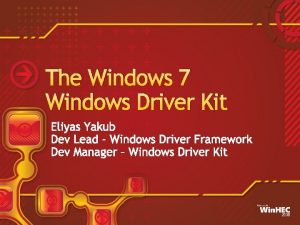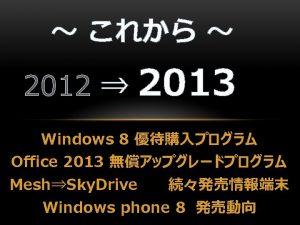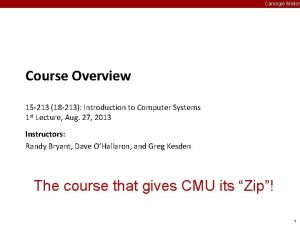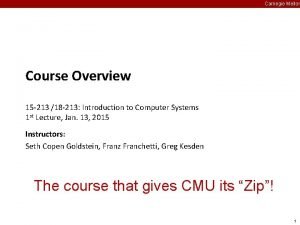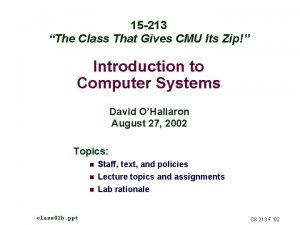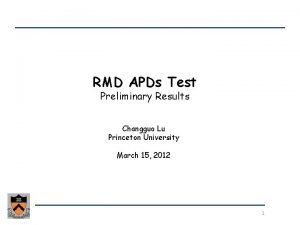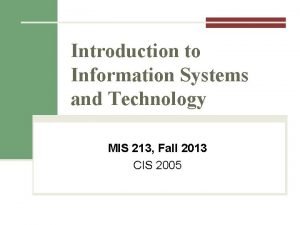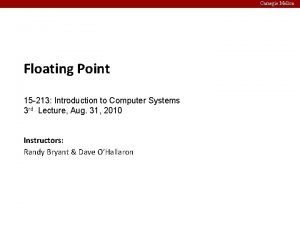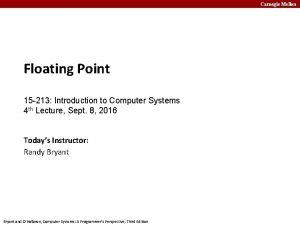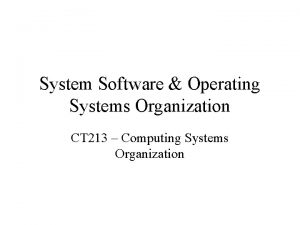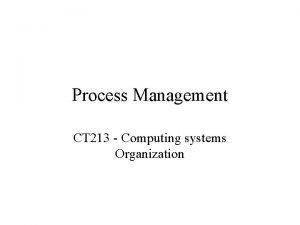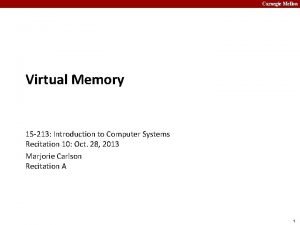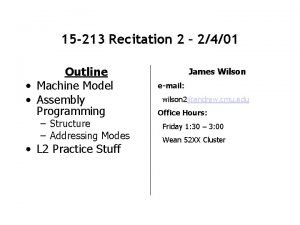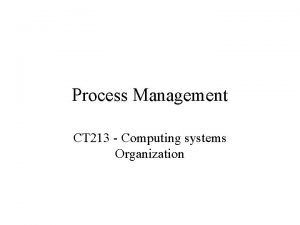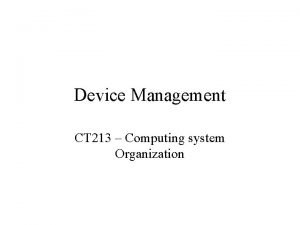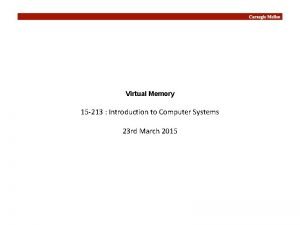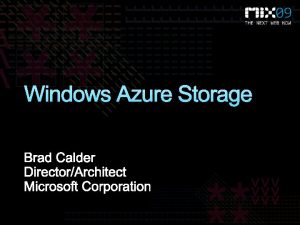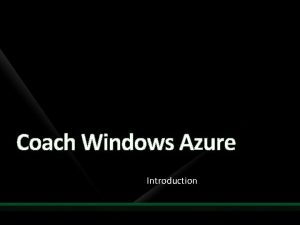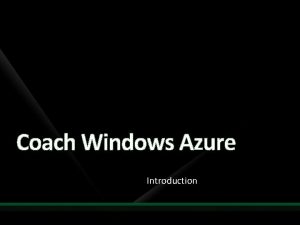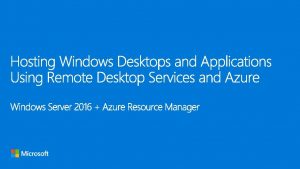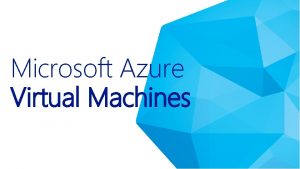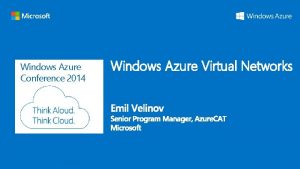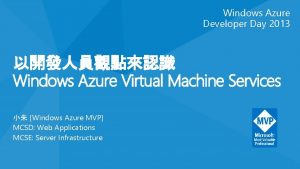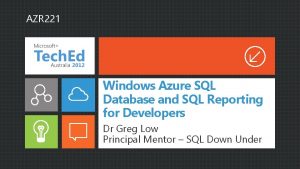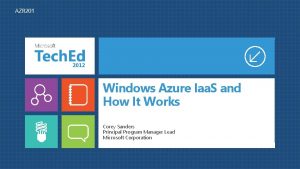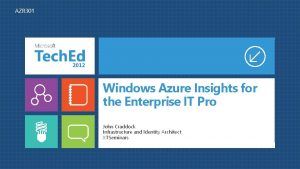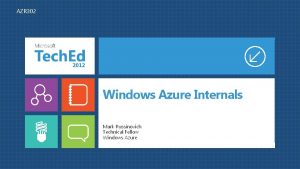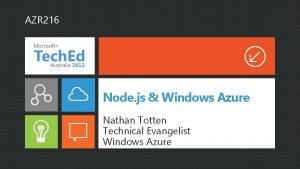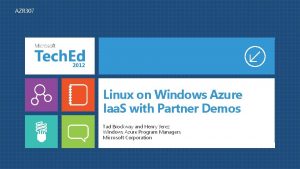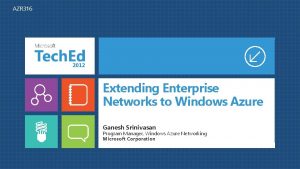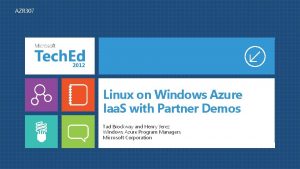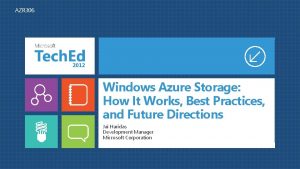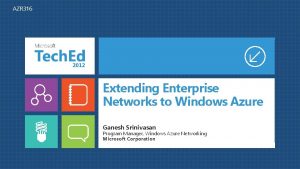AZR 213 Windows Azure Virtual Machines and Virtual













































- Slides: 45

AZR 213 Windows Azure Virtual Machines and Virtual Networks Michael Washam Senior Technical Evangelist MWasham. MS


IT Pro experience Key server applications and migration on ramp Easy storage manageability High availability features Advanced networking Integration with compute Paa. S

VM Role Virtual Machine Storage Non-Persistent Storage Easily additional storage Deployment Build VHD offsite and upload to storage. Build VHD directly in the cloud or build the VHD offsite and upload Networking Internal and Input Endpoints configured through service model. Internal Endpoints are open by default. Access control with firewall on guest OS. Input endpoints controlled through portal, service model or API/Script. Primary Use Deploying applications with long or complex installation requirements into stateless Paa. S applications Applications that require persistent storage to easily run in Windows Azure.

Cloud First Provisioning Windows Server Management Portal >_ Scripting (Windows, Linux and Mac) Boot VM from New Disk Linux Extra Small Medium Large REST API X-Large Cloud

Bring Your Own Server/VHD On-Premises Cloud My. App. vhd Provision VM from Image or Disk using portal, script or API On Premises Virtual Server Use Cases • Forklift Migration of VMs • Sys Prepped Images VHD Must Be Fixed Disk * CSUpload Can Convert on Upload VHD Create Disk or Image

Imaging VMs in the Cloud Base. VHD Identical/similar deployment instances using common OS image as start Boot VM Customize VHD Generalize VHD Capture VM Saves Customized Image to Your Image Library

Windows Server 2008 R 2 with SQL Server 2012 Evaluation Windows Server 2008 R 2 with Biz. Talk 2010 R 2 CTP (NEW) Windows Server 2012 Open. SUSE 12. 1 Cent. OS 6. 2 Ubuntu 12. 04 SUSE Linux Enterprise Server SP 2

Virtual Machine Storage Windows Azure Storage

Disks and Images Base OS image for new Virtual Machines Sys-Prepped/Generalized/Read Only Custom images created by uploading or by capture Writable Disks for Virtual Machines Created during VM creation or during upload of existing VHDs.

VM Size CPU Cores Memory Bandwidth # Data Disks Extra Small Shared 768 MB 5 (Mbps) 1 Small 1 1. 75 GB 100 (Mbps) 2 Medium 2 3. 5 GB 200 (Mbps) 4 Large 4 7 GB 400 (Mbps) 8 Extra Large 8 14 GB 800 (Mbps) 16 Each Persistent Data Disk Can be up to 1 TB

Disk Type Default Supported OS Disk Read. Write Read. Only and Read. Write Data Disk None, Read. Only and Read. Write Modify using Set-Azure. OSDisk or Set-Azure. Data. Disk

DEMO Getting Started

Virtual Machines and Cloud Services

Cloud Service is a management, configuration, security, networking and service model boundary VM 2 VM 3 VM 4 VM 5 VM… ROLES VM 1 INSTANCES CLOUD SERVICE

Virtual Machines are roles with exactly one instance IMPLICIT CLOUD SERVICE VM

Multiple Virtual Machines can be hosted within the same cloud service CLOUD SERVICE VM VM

DEMO Virtual Machines and Cloud Service

Virtual Machine Availability

99. 95% for multiple role instances 4. 38 hours of downtime per year 99. 9% forfor single role instances 99. 9% single role instances 8. 75 hours 8. 75 of downtime per year hours of downtime What’s included Compute Hardware failure (disk, cpu, memory) Datacenter failures - Network failure, power failure Hardware upgrades, Software maintenance – Host OS Updates Planned downtime – 6 day notice, 6 hour window, 25 minute downtime What is not included VM OS/Software crashes, Guest OS Updates

SQL Server Virtual Machine SQL Server Primary Virtual Machine SQL Server Secondary Virtual Machine

Fault Domain Rack Web Role INSTANCE Worker Role INSTANCE

Update Domains are honored by host OS updates Fault Domain Rack Virtual Machine IIS 1 Availability Set IIS 2 UD #1 UD #2 Virtual Machine SQL 1 UD #1 Availability Set SQL 2 UD #2

Windows Azure Networking

Full control over machine names Windows Azure provided DNS Resolves VMs by name within the same cloud service Machine names are modeled explicitly and registered in the DNS service Bring your own DNS server Use your on-premise DNS servers Deploy a DNS server in Windows Azure Use public DNS services

UDP Traffic Supported in WA Load-balanced incoming traffic and allows outbound traffic Support for All IP-Based Protocols (VM to VM) Instance-to-instance communication TCP, UDP and ICMP, dynamic ports Port Forwarded Endpoints Direct communication to multiple VMs in the same cloud app Custom Load Balancer Health Probes Health check with probe timeouts HTTP based probing, allowing granular control of health checks

Endpoint Public Port Local Port Protocol (TCP/UDP) Name Cloud App/Hosted Service PORT 5586 PORT 3389 VM 1 LB/IP PORT 5587 PORT 3389 VM 2

Endpoint Set Public Port Local Port Protocol (TCP/UDP) Name Cloud App VM 1 LBHTTP PORT 80 LB VM 2 LBHTTP VM 3 LBHTTP

Load Balancer Probe Set Name Protocol (TCP) Probe Port Probe Path (/healthcheck. aspx) Looks for HTTP 200 15 second polling Cloud App VM 1 /healthcheck. aspx PORT 80 LB VM 2 /healthcheck. aspx VM 3 /healthcheck. aspx

DEMO Virtual Machine Networking

Cross-premise Connectivity ENTERPRISE Data Synchronization SQL Azure Data Sync Application-layer Connectivity & Messaging Service Bus Secure Machine-to-Machine Network Connectivity Windows Azure Connect Secure Site-to-Site Network Connectivity Windows Azure Virtual Network

Windows Azure VM 1 Subnet 2 VM 2 ROLE 1 Subnet 1 Your “virtual” branch office/ datacenter in the cloud Enables customers to extend their Enterprise Networks into Azure Networking on-ramp for migrating existing apps and services to Windows Azure Enables “hybrid” apps that span cloud and their premises A protected private virtual network in the cloud Enables customers to setup secure private IPv 4 networks fully contained within Windows Azure IP address persistence Inter-service DIP-to-DIP communication

SQL Farm IIS Servers AD / DNS S 2 S VPN Device Share. Point File Servers Exchange Paa. S Roles Local AD SQL VMs

Contoso. VNet (10. 0/8) Cloud Service 1 Front. End. Subnet (10. 0/16) Load Balancer Protect virtual machines from the open Internet IIS Virtual Machines Direct Access via VNET Cloud Service 2 SQLSubnet (10. 1. 0. 0/16) SQL Mirror Windows Azure provided DNS does not span cloud services

v. Net Gateway LAN 1 00 10 00 0 10 010 1 10 00 010 1 0 0 1 1 0 0 01 1 01 01 111 0 00 VPN Vnet

DEMO Hybrid Networking with Virtual Networks


Connect Cloud Apps via VIPs Easily compose services by connecting public endpoints Direct Connectivity Using Virtual Networking For advanced connectivity scenarios such as Active Directory or DCOM Mixed Mode: VM and Paa. S Roles in the Same Cloud Service Simple, secure and highly efficient method of using Iaa. S and Paa. S side-by-side

Strengths Cloud Service 1 Load Balancer Simplicity Tenant Autonomy VIP Swap (stateless roles) Easy Local Dev/Test Persistent Service is Easily Accessible (even from other services!) Weaknesses SQL Data Access Traffic Through Public Endpoint WA Web Role Secure Endpoints with Firewall Cloud Service 2 Higher Latency Less Secure Management/ Deployment Overhead SQL Server Load Balancer

Strengths More Secure Low Latency Cloud Service Autonomy VIP Swap (stateless roles) Advanced Connectivity Requirements Contoso. VNet (10. 0/8) Cloud Service 1 Front. End. Subnet (10. 0/16) WA Web Role Load Balancer Direct Access via VNET Weaknesses Cloud Service 2 VNET Complexity No Windows Azure provided DNS AD AD Subnet (10. 2. 0. 0/16) SQLSubnet (10. 1. 0. 0/16) SQL Mirror

Strengths Windows Azure Provided DNS Low latency connectivity Single deployment, update and management unit Cloud Service Weaknesses No VIP Swap (coming in the future Virtual Machine 80 Load Balancer WA Web Role

DEMO Iaa. S and Paa. S

http: //www. windowsazure. com http: //michaelwasham. com http: //bit. ly/Windows. Azure. TK

IT Pro experience Key server applications and migration on ramp Easy storage manageability High availability features Advanced networking Integration with compute Paa. S

 What is windows azure virtual machine
What is windows azure virtual machine Virtualbox windows xp download
Virtualbox windows xp download Csp azure plan
Csp azure plan Windows azure hyper v recovery manager
Windows azure hyper v recovery manager Kentico windows azure development
Kentico windows azure development Windows azure private cloud
Windows azure private cloud Azure platform overview
Azure platform overview Pentesting virtual machines
Pentesting virtual machines Virtual machines
Virtual machines Windows movie maker themes
Windows movie maker themes Windows media player 9 for windows 10
Windows media player 9 for windows 10 Windows live mail windows 8
Windows live mail windows 8 Windows driver kit windows 7
Windows driver kit windows 7 Windows movie maker download microsoft
Windows movie maker download microsoft Windows media player 7 skins
Windows media player 7 skins Windows identity foundation windows 10
Windows identity foundation windows 10 Windws update
Windws update Windows mobile center windows 10
Windows mobile center windows 10 2012 movie maker
2012 movie maker Ipseq
Ipseq Windows xp
Windows xp 132 213
132 213 Sbi 213
Sbi 213 Cs 213 northwestern
Cs 213 northwestern Cow.ceng.metu.edu tr
Cow.ceng.metu.edu tr Cmu 213
Cmu 213 15 213 cmu
15 213 cmu Ceng 213
Ceng 213 15 213
15 213 Round 34 to 3 s.f
Round 34 to 3 s.f Zva-213-s+
Zva-213-s+ Mis 213 uncw
Mis 213 uncw 15 213
15 213 15 213
15 213 Ct 213
Ct 213 5 state process model
5 state process model 213 table
213 table 15 213
15 213 5 cfr 213,3102(u)
5 cfr 213,3102(u) Ct-213
Ct-213 Poli 213
Poli 213 Ct 213
Ct 213 Ee 213
Ee 213 Ee 213
Ee 213 15-213 introduction to computer systems
15-213 introduction to computer systems 15-213 introduction to computer systems
15-213 introduction to computer systems



